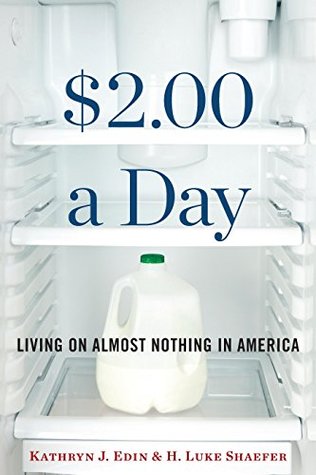More on this book
Community
Kindle Notes & Highlights
Started reading
December 27, 2023
Two dollars is less than the cost of a gallon of gas, roughly equivalent to that of a half gallon of milk. Many Americans have spent more than that before they get to work or school in the morning. Yet in 2011, more than 4 percent of all households with children in the world’s wealthiest nation were living in a poverty so deep that most Americans don’t believe it even exists in this country.
It seemed as though not only cash was missing, but hope as well.
In early 2011, 1.5 million households with roughly 3 million children were surviving on cash incomes of no more than $2 per person, per day in any given month.
As of 2011, the number of families in $2-a-day poverty had more than doubled in just a decade and a half.
It further appeared that the experience of living below the $2-a-day threshold didn’t discriminate by family type or race. While single-mother families were most at risk of falling into a spell of extreme destitution, more than a third of the households in $2-a-day poverty were headed by a married couple. And although the rate of growth was highest among African Americans and Hispanics, nearly half of the $2-a-day poor were white.
When Shaefer added in SNAP as if it were cash—a problematic assumption because SNAP cannot legally be converted to cash, so it can’t be used to pay the light bill, the rent, or buy a bus pass—the number of families living in $2-a-day poverty fell by about half. This vital in-kind government program was clearly reaching many, though not all, of the poorest of the poor. Even counting SNAP as cash, though, Shaefer found that the increase in the number of families with children living in $2-a-day poverty remained large—up 70 percent in fifteen years. And even after throwing in any tax credits the
...more
With this in mind, we began to look for other evidence, beyond the SIPP, of the rise of $2-a-day poverty. Reports from the nation’s food banks showed a sizable rise in the number of households seeking emergency food assistance since the late 1990s. A look at government data on those receiving SNAP revealed a large increase in the number of families with no other source of income. And reports from the nation’s public schools showed that more and more children were facing homelessness. Taken together, these findings seemed to confirm the rise of a new form of poverty that defies every assumption
...more
In 1995, Senator Daniel Patrick Moynihan famously predicted that the proposed welfare reform would result in children “sleeping on grates.” Most observers think history proved him wrong. But does the rise in the number of the $2-a-day poor represent the (until now unexamined) great failure of welfare reform? Perhaps Moynihan was not so far off after all. Perhaps his only mistake was in assuming that this failure at the very bottom of the economic distribution would be visible and obvious, when in fact, throughout history, American poverty has generally been hidden far from most Americans’
...more
This book is about what happens when a government safety net that is built on the assumption of full-time, stable employment at a living wage combines with a low-wage labor market that fails to deliver on any of the above.
A hidden but growing landscape of survival strategies among those who experience this level of destitution has been the result. At the community level, these strategies can pull families into a web of exploitation and illegality that turns conventional morality upside down.
The kind-looking woman in front of Modonna seems prematurely old. She turns to Modonna and relates how she struggled to get Medicaid for her oldest adult son, desperately ill and then hospitalized with AIDS. Roadblock after roadblock held up the process; months passed and he died—the day before his medical card arrived in the mail. Now she is here again, this time to apply for Medicaid on behalf of her younger adult son, who is also chronically ill and in need of treatment.
Out of every one hundred Americans, fewer than two get aid from today’s cash welfare program. Just 27 percent of poor families with children participate. There are more avid postage stamp collectors in the United States than welfare recipients.
At the old welfare program’s height in 1994, it served more than 14.2 million people—4.6 million adults and 9.6 million children. In 2012, the year Modonna took her trip to the DHS office, there were only 4.4 million people left on the rolls—1.1 million adults (about a quarter of whom were working) and 3.3 million kids. That’s a 69 percent decline. By fall 2014, the TANF caseload had fallen to 3.8 million.
Poverty rose to the top of the public agenda in the 1960s, in part spurred by the publication of Michael Harrington’s The Other America: Poverty in the United States. Harrington’s 1962 book made a claim that shocked the nation at a time when it was experiencing a period of unprecedented affluence: based on the best available evidence, between 40 million and 50 million Americans—20 to 25 percent of the nation’s population—still lived in poverty, suffering from “inadequate housing, medicine, food, and opportunity.”


